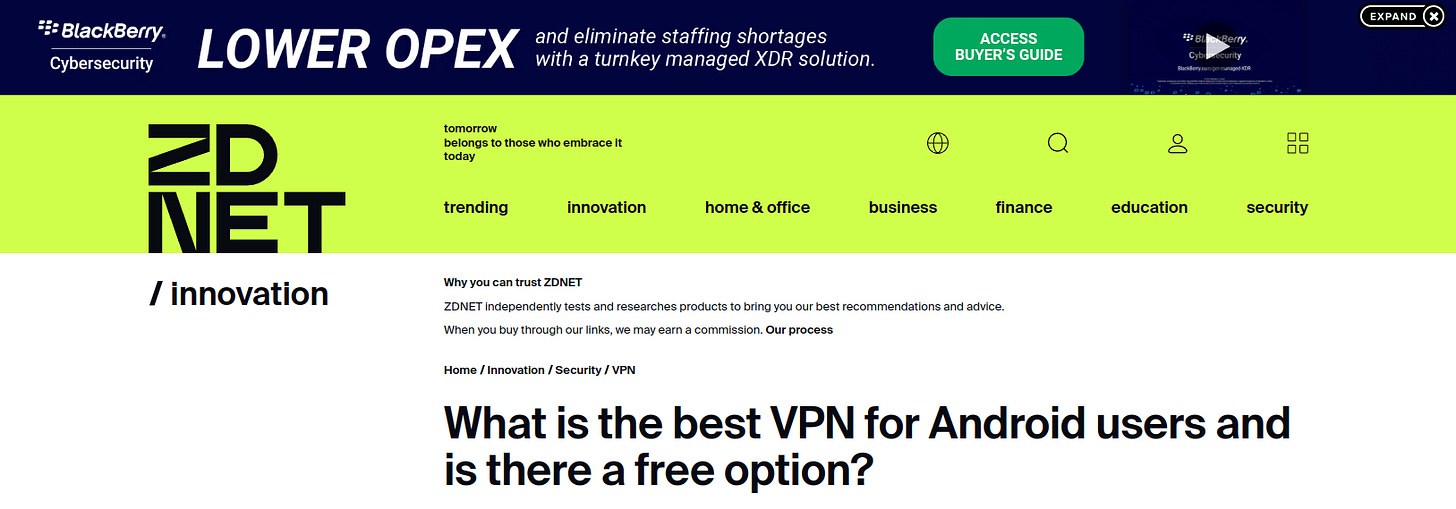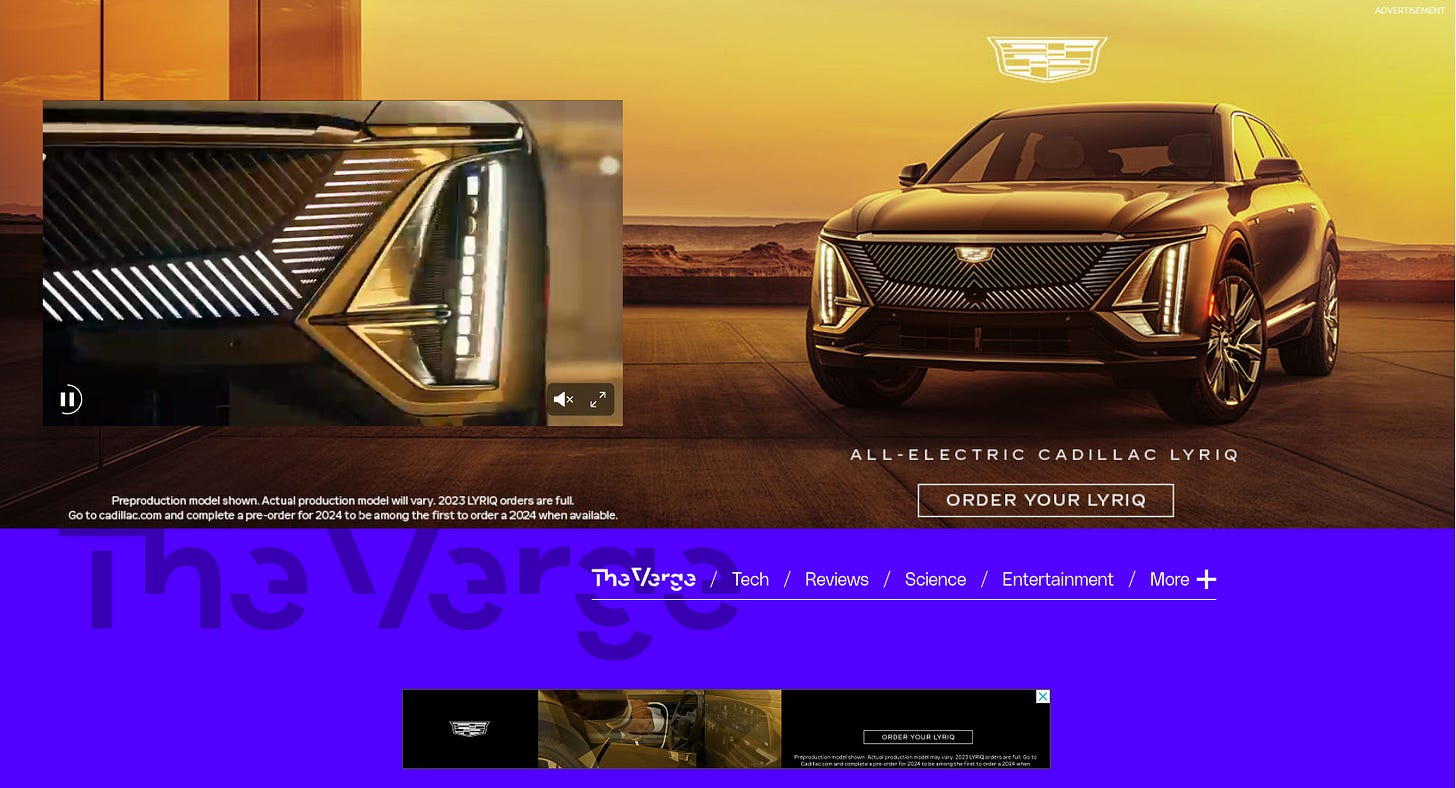I am going to put forward a simple idea:
Advertising is absolutely destroying Technology Journalism.
To prove that point, I would like to point you to the current front page of ZDNet. Which looks like this:
Note the absolutely immense size of the advertisement across the top. That’s annoying, to be sure. But that’s not the big issue here.
To get to the heart of this problem… to really dive down into this… let’s look at the top article on ZDNet today: “What is the best VPN for Android users and is there a free option?”
At the moment, the top of that article looks like this:
Ok. Sure. Seems like a valid idea for an article. A rundown of the VPN options for Android. Could be useful information here!
So.
What, exactly, do the esteemed writers for ZDNet consider to be the best VPN for Android?
The ZDNet winner is… NordVPN!
Is ZDNet getting paid for that opinion?
Now, here’s the thing, NordVPN may be great. I’m not going to knock it here.
What I will point out is that this is the URL that ZDNet uses to link people to NordVPN:
https://go.nordvpn.net/aff_c?offer_id=378&aff_id=307&source=zdnet&aff_sub=zd-3156339e8da34582b5473a1232a26efa-dtp&aff_sub2=bestandroidvpn22Take a good look at that. That’s an affiliate link.
Meaning: It is highly likely that ZDNet is being paid, in some way, for sending new customers to NordVPN.
And, what’s wild here, is that ZDNet uses affiliate links for all of the VPN options they are “reviewing”.
ExpressVPN:
https://xvctlink.com/?offer=3monthsfree&a_fid=zdnet&&aff_sub=zd-ed2f6076b0b64bf78ec9ad2cf0f8893a-dtp&aff_sub2=bestandroidvpn22IPVanish:
https://www.anrdoezrs.net/click-9041660-14542878?sid=%5Bsubid_value%5D?sid2=bestandroidvpn22SurfShark VPN:
https://get.surfshark.net/aff_c?offer_id=50&aff_id=1511&source=zdnet&aff_sub=zd-3a43bbe8abec4ee288576f395335d1fa-dtp&aff_sub2=bestandriodvpn22Which means this is not so much an article… as a large advertisement and “click factory” to drive traffic either towards current (or potential) advertisers… or affiliate programs that pay per sign up (or click).
“But that’s just one article, Lunduke! Surely that’s not representative of all of ZDNet’s articles!”
Ok. How about the second article on ZDNet at this exact moment?
Entitled: “Run, don't walk: These PC deals include a $500 savings on an HP Omen rig”
Here are the 5 computer “deals” that ZDNet wants you to know about in this “article”:
The links for every single one are affiliate links.
Not one computer is listed that doesn’t contain an affiliate link that provides benefit / profit for ZDNet. Not one.
And it’s not just ZDNet
I could pick on ZDNet all day long. Because, quite frankly, their articles appear to predominantly either consist of “Hey buy this using our affiliate link” pieces… or obvious attempts at promoting or pleasing current (or potential) advertisers.
One “article” after another. All significantly more “advertisement” than “article”.
But, here’s the thing… ZDNet is not the only publication that has taken this approach.
CNet tells you “AirTags In Checked Bags? Why I'll Never Travel Without Them Again” while trying to sell you the AirTags with affiliate links — and large, overbearing advertisements with partners of Apple (who makes the AirTags).
The Verge… well… I think The Verge just wants me to buy this car:
While these examples are obvious — and a bit overwhelmingly ridiculous — smaller, less obvious examples fill the entire Tech Journalism space.
From magazines to podcasts… big and small… advertising is significantly impacting the tech and computer news that you read. Publishers, writers, YouTubers, and podcasters are — more often than not — deeply impacted by the companies that give them money, equipment, and other goodies.
Even those using “ad networks” like Google AdWords (and YouTube) are often carefully choosing their content based on how given “key words” will perform for them in terms of not just total views (often via search or recommendation algorithms)… but the amount they are paid per view.
So… what do we do about it?
Obviously this is a problem. There are very, very few Tech Publications that do not derive the majority of their revenue through advertising for the very companies that they are supposed to be covering.
Can you trust a phone review site that advertises for Apple, Samsung, or any other smartphone maker?
No. Of course not.
And, even if that publication does not currently advertise for one of those companies… there’s always the possibility they might in the future. Which means they are going to always have a thought — in the back of their mind, at the very least — about keeping that company happy with that. Making it possible to run their ads in the future.
Take it from someone who’s been in this business (on both the publishing side — magazines, podcasts, and shows — as well as the corporate advertising side)…
Anyone telling you that this isn’t impacting nearly every major publication — in a big way — is lying to you.
There is only one possible way to solve the problem.
One way to make a publication trustworthy… to make the quality (and honesty) of the content improve.
A publication must drop advertising — entirely — and move to another model for generating operating revenue.
There’s no choice in the matter. That’s the only way.
Subscriptions. Physical or digital media sales. Selling shirts. Whatever the mechanism to generate the revenue, the key is that advertising for companies — that you might possibly cover — must be off the table.
Now, if a Tech Publication wants to advertise for, say, donuts or breakfast sausages? You could make an argument that the potential impact on the publication, from such a deal, would be low.
But a publisher of computer-related content advertising for computer companies? It’s going to have an impact. And, as you can see from the examples above, it’s not a positive one.











Byte had this on lockdown. They’d sell spots to anyone, as big as the people wanted, and just make the magazine thicker to accommodate their insanely long and in-depth articles, at least for the first 20 years, and then in the late 90s, they kind of succumbed afaik.
Aside from conflicts of interest, mainstream websites are so encrusted with ads they look grotesque. Are there really so many actual people who check out that mess and even click it?